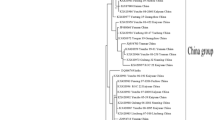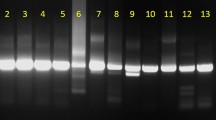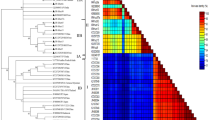Abstract
A total of 332 sugarcane leaf samples were collected from seven provinces in China during 2010 to 2013. RT-PCR was performed using the YLS111/YLS462 primers to detect the causal pathogen Sugarcane yellow leaf virus (SCYLV) causing yellow leaf disease in sugarcane. The incidence of SCYLV infection ranged from 24 to 38 % depending on geographic areas. A new primer pair (P0-R3/P0-F2) was designed to prime the amplification of a 968-nucleotide (nt) fragment from SCYLV-positive samples. The fragment contained a partial 5′ untranslated region, the complete ORF0 encoding P0, and a partial ORF1. A phylogenetic analysis of 141 P0 fragment sequences (937 nt) worldwide showed that all SCYLV isolates were clustered into eight genotypes. The 107 SCYLV isolates collected in this study were classified into three genotypes (BRA, HAW, and CHN3), of which the BRA genotype (102/107) was the most prevalent and was detected in all evaluated locations. One isolate (1/107) of genotype HAW was found in Hainan province. Four isolates (4/107) of the genotype CHN3 were observed in Guangxi, Guizhou and Hainan provinces. These findings help understand the genotypic diversity and distribution of SCYLV isolates in China.


Similar content being viewed by others
References
Abu Ahmad Y, Rassaby L, Royer M, Borg Z, Braithwaite KS, Mirkov TE, Irey M, Perrier X, Smith G, Rott P (2006a) Yellow leaf of sugarcane is caused by at least three different genotypes of sugarcane yellow leaf virus, one of which predominates on the Island of Reunion. Arch Virol 151:1355–1371
Abu Ahmad Y, Royer M, Daugrois JH, Costet L, Lett JM, Victoria JI, Girard JC, Rott P (2006b) Geographical distribution of four sugarcane yellow leaf virus genotypes. Plant Dis 90:1156–1160
Abu Ahmad Y, Costet L, Daugrois JH, Nibouche S, Letourmy P, Girard JC, Rott P (2007) Variation in infection capacity and in virulence exists between genotypes of sugarcane yellow leaf virus. Plant Dis 91:253–259
Aljanabi SM, Parmessur Y, Moutia Y, Saumtally S, Dookun A (2001) Further evidence of the association of a phytoplasma and a virus with yellow leaf syndrome in sugarcane. Plant Pathol 50:628–636
Berry S, Brune AE, Rutherford RS (2002) Development of new methods for diagnosing yellow leaf syndrome. Proc S Afr Sugar Technol Assoc 76:590–592
Chinnaraja C, Viswanathan R, Karuppaiah R, Bagyalakshmi K, Malathi P, Parameswari B (2013) Complete genome characterization of sugarcane yellow leaf virus from India: evidence for RNA recombination. Eur J Plant Pathol 135:335–349
Comstock JC, Irey MS, Lockhat BEL, Wang ZK (1998) Incidence of yellow leaf syndrome in CP cultivars based on polymerase chain reaction and serological techniques. Sugar Cane 4:21–24
Comstock JC, Miller JD, Schnell RJ (2001) Incidence of sugarcane yellow leaf virus in clones maintained in the world collection of sugarcane and related grasses at the United States national repository in Miami, Florida. Sugar Tech 3:128–133
D’Arcy C, Domier L (2005) Luteoviridae. In: Fauquet CM, Mayo MA, Maniloff J, Desselberger U, Ball LA (eds) Virus taxonomy: VIIIth report of the international committee on taxonomy of viruses. Elsevier Academic Press, New York, pp 891–900
Edgar RC (2004) MUSCLE: multiple sequence alignment with high accuracy and high throughput. Nucleic Acids Res 32:1792–1797
ElSayed AI (2013) Maize (Zea mays L.) constitutes a novel host to sugarcane yellow leaf virus. Can J Plant Pathol 35:68–74
ElSayed AI, Komor E (2012) Investigation of ORF0 as a sensitive alternative diagnostic segment to detect sugarcane yellow leaf virus. J Gen Plant Pathol 78:207–216
ElSayed AI, Weig AR, Komor E (2011) Molecular characterization of Hawaiian sugarcane yellow virus leaf genotypes and their phylogenetic relationship to strains from other sugarcane-growing countries. Eur J Plant Pathol 129:399–412
Gao SJ, Pan YB, Chen RK (2010) Detection of sugarcane yellow leaf virus by direct antigen coated enzyme-linked immunosorbent assay. Chine J Trop Crops 31:1356–1361, in Chinese, with English abstract
Gao SJ, Lin YH, Pan YB, Damaj MB, Wang QN, Mirkov TE, Chen RK (2012) Molecular characterization and phylogenetic analysis of sugarcane yellow leaf virus isolates from China. Virus Genes 45:340–349
Goncçalves MC, Klerks MM, Verbeek M, Vega J, van den Heuvel JFJM (2002) The use of molecular beacons combined with NASBA for the sensitive detection of sugarcane yellow leaf virus. Eur J Plant Pathol 108:401–407
Korimbocus J, Coates D, Barker I, Boonham N (2002) Improved detection of sugarcane yellow leaf virus using a real-time fluorescent (TaqMan) RT-PCR assay. J Virol Methods 103:109–120
Lehrer AT, Komor E (2008) Symptom expression of yellow leaf disease in sugarcane cultivars with different degrees of infection by sugarcane yellow leaf virus. Plant Pathol 57:178–189
Lehrer AT, Schenck S, Yan SL, Komor E (2007) Movement of aphid-transmitted sugarcane yellow leaf virus (ScYLV) within and between sugarcane plants. Plant Pathol 56:711–717
Lehrer AT, Wu KK, Komor E (2009) Impact of sugarcane yellow leaf virus (SCYLV) on growth and sugar yield of sugarcane. J Gen Plant Pathol 75:288–296
Li YR, Yang LT (2015) Sugarcane agriculture and sugar industry in China. Sugar Tech 17:1–8
Lin YH, Gao SJ, Damaj MB, Fu HY, Chen RK, Mirkov TE (2014) Genome characterization of sugarcane yellow leaf virus from China reveals a novel recombinant genotype. Arch Virol 159:1421–1429
Lockhart BEL, Irey MS, Comstock JC (1996) Sugarcane bacilliform virus, sugarcane mild mosaic virus, and sugarcane yellow leaf syndrome. In: Croft BJ, Piggin CT, Wallis ES, Hogarth DM (Eds.) Sugarcane germplasm conservation and exchange. Canberra, Australia. Australian Centre for International Agricultural Research (ACIAR). pp. 108–112
Mangwende T, Wang ML, Borth W, Hu J, Moore PH, Mirkov TE, Albert HH (2009) The P0 gene of sugarcane yellow leaf virus encodes an RNA silencing suppressor with unique activities. Virology 384:38–50
Martin RR, Keese PK, Young JM, Waterhouse PM, Gerlach WL (1990) Evolution and molecular biology of luteoviruses. Annu Rev Phytopathol 28:341–363
Moonan F, Mirkov TE (2002) Analyses of genotypic diversity among North, South, and Central American isolates of sugarcane yellow leaf virus: evidence for Colombian origins and for intraspecific spatial phylogenetic variation. J Virol 76:1339–1348
Moonan F, Molina J, Mirkov TE (2000) Sugarcane yellow leaf virus: an emerging virus that has evolved by recombination between luteoviral and poleroviral ancestors. Virology 269:156–171
Pazhouhandeh M, Dieterle M, Marrocco K, Lechner E, Berry B, Brault V, Hemmer O, Kretsch T, Richards KE, Genschik P, Ziegler GV (2006) F-box-like domain in the polerovirus protein P0 is required for silencing suppressor function. Proc Natl Acad Sci U S A 103:1994–1999
Rott P, Comstock JC, Croft BJ, Kusalwong A, Saumtally S (2005) Advances and challenges in sugarcane pathology: a review of the 2003 pathology workshop. Proc Int Soc Sugar Cane Technol 25:607–614
Schenck S (1990) Yellow leaf syndrome—a new sugarcane disease. Hawaii Sugar Plant Assoc Annu Rep, 38–39
Schenck S, Lehrer AT (2000) Factors affecting the transmission and spread of sugarcane yellow leaf virus. Plant Dis 84:1085–1088
Schenck S, Hu JS, Lockhart BEL (1997) Use of a tissue blot immunoassay to determine the distribution of sugarcane yellowleaf virus in Hawaii. Sugar Cane 4:5–8
Smith GR, Borg Z, Lockhart BEL, Braithwaite KS, Gibbs MJ (2000) Sugarcane yellow leaf virus: a novel member of the Luteoviridae that probably arose by inter-species recombination. J Gen Virol 81:1865–1869
Tamura K, Peterson D, Peterson N, Stecher G, Nei M, Kumar S (2011) MEGA5: Molecular evolutionary genetics analysis using maximum likelihood, evolutionary distance, and maximum parsimony methods. Mol Biol Evol 28:2731–2739
Vega J, Scagluisi SM, Ulian EC (1997) Sugarcane yellow leaf disease in Brazil: evidence of association with a luteovirus. Plant Dis 81:21–26
Viswanathan R (2004) Ratoon stunting disease infection favours severity of yellow leaf syndrome caused by sugarcane yellow leaf virus in sugarcane. Sugar Cane Int 22:3–7
Viswanathan R, Balamuralikrishnan M, Karuppaiah R (2008) Identification of three genotypes of sugarcane yellow leaf virus causing yellow leaf disease from India and their molecular characterization. Virus Genes 37:368–379
Wang MQ, Zhou GH (2010) A near-complete genome sequence of a distinct isolate of sugarcane yellow leaf virus from China, representing a sixth new genotype. Virus Genes 41:268–272
Wang MQ, Xu DL, Li R, Zhou GH (2012) Genotype identification and genetic diversity of sugarcane yellow leaf virus in China. Plant Pathol 61:986–993
Xie YJ, Wang MQ, Xu DL, Li RH, Zhou GH (2009) Simultaneous detection and identification of four sugarcane by one-step RT-PCR. J Virol Methods 162:64–68
Zhou GH, Li JG, Xu DL, Shen WK, Deng HH (2006) Occurrence of sugarcane yellow leaf virus in Southern China and its transmission by the sugarcane-colonizing aphid, Ceratovacuna lanigera. Sci Agric Sin 39:2023–2027, in Chinese, with English abstract
Zhu YJ, Lim STS, Schenck S, Albert Arcinas A, Komor E (2010) RT-PCR and quantitative real-time RT-PCR detection of sugarcane yellow leaf virus (SCYLV) in symptomatic and asymptomatic plants of Hawaiian sugarcane cultivars and the correlation of SCYLV titre to yield. Eur J Plant Pathol 127:263–273
Acknowledgments
This research was supported by a grant from the National Natural Science Foundation of China (31170345) and an Earmarked Fund from the China Agriculture Research System (CARS-20-2-4). The authors wish to express sincere thanks to the scientists in CARS for collecting the sugarcane leaf samples. We also thank Yong-Bao Pan at the USDA-ARS, Sugarcane Research Unit, Houma, LA, USA for critically review of the manuscript.
Author information
Authors and Affiliations
Corresponding authors
Additional information
Section Editor: Alice Nagata
Yi-Hua Lin and Xiao-Bin Wu contributed equally to this work.
Electronic supplementary material
Below is the link to the electronic supplementary material.
Supplementary Table S1
Sources of sugarcane yellow leaf virus (SCYLV) P0 fragment sequences used in this study. (DOC 220 kb)
Supplementary Figure S1
Phylogenetic tree based on the multiple sequence alignment among the nucleotide sequences of a 771-nt P0 gene from 141 sugarcane yellow leaf virus (SCYLV) isolates (107 from this study marked with an asterisk plus 34 from the GenBank database). The tree was constructed using the neighbor-joining (NJ) method and the Kimura 2-parameter substitution model with bootstrap resampling of 1000 replications. Isolates of the BRA genotype were condensed as a triangle. (DOCX 255 kb)
Rights and permissions
About this article
Cite this article
Lin, YH., Wu, XB., Liu, YH. et al. Molecular detection, genetic diversity and distribution of Sugarcane yellow leaf virus genotypes in China. Trop. plant pathol. 40, 200–207 (2015). https://doi.org/10.1007/s40858-015-0037-5
Received:
Accepted:
Published:
Issue Date:
DOI: https://doi.org/10.1007/s40858-015-0037-5




